radiator cap DODGE DURANGO SRT 2018 Owners Manual
[x] Cancel search | Manufacturer: DODGE, Model Year: 2018, Model line: DURANGO SRT, Model: DODGE DURANGO SRT 2018Pages: 568, PDF Size: 6.54 MB
Page 385 of 568
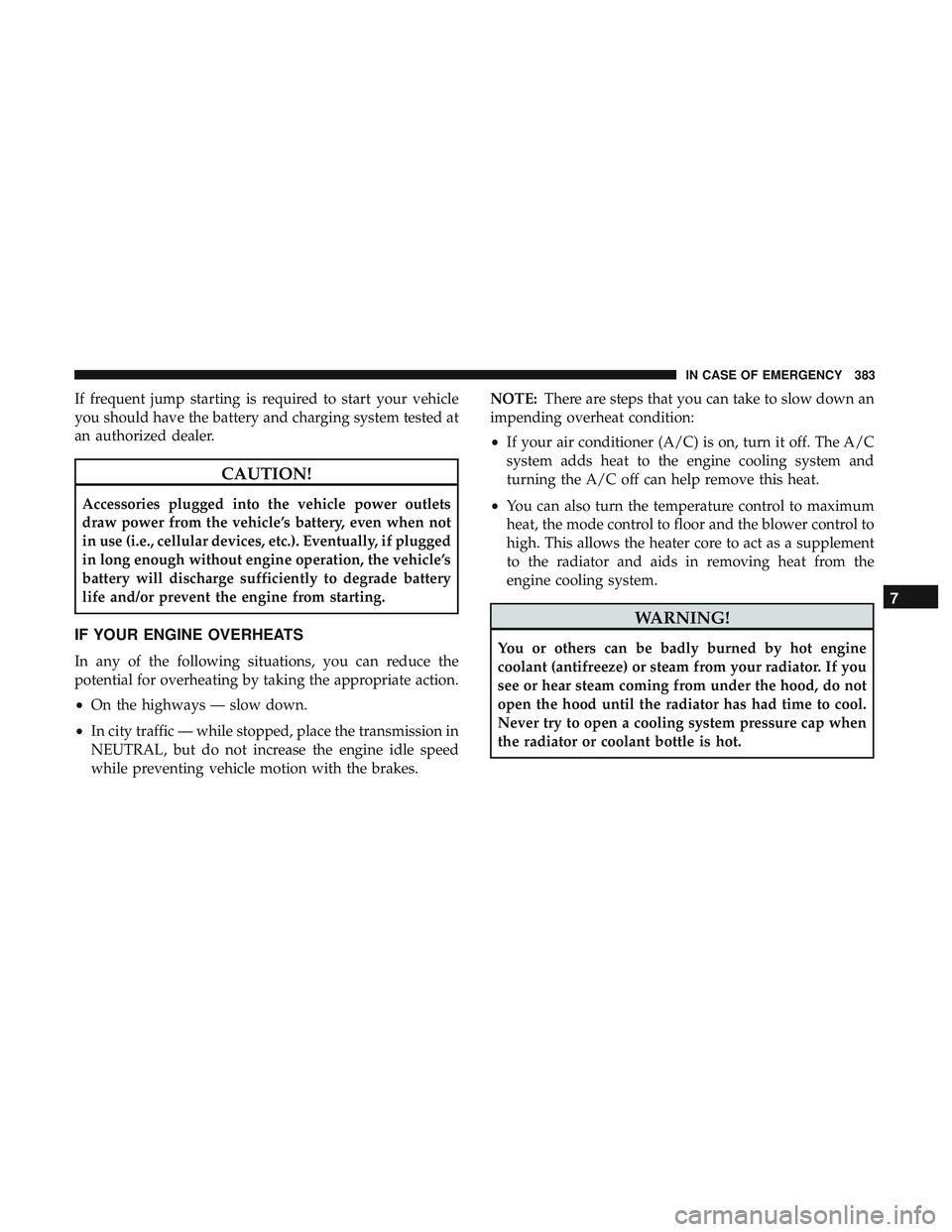
If frequent jump starting is required to start your vehicle
you should have the battery and charging system tested at
an authorized dealer.
CAUTION!
Accessories plugged into the vehicle power outlets
draw power from the vehicle’s battery, even when not
in use (i.e., cellular devices, etc.). Eventually, if plugged
in long enough without engine operation, the vehicle’s
battery will discharge sufficiently to degrade battery
life and/or prevent the engine from starting.
IF YOUR ENGINE OVERHEATS
In any of the following situations, you can reduce the
potential for overheating by taking the appropriate action.
•On the highways — slow down.
• In city traffic — while stopped, place the transmission in
NEUTRAL, but do not increase the engine idle speed
while preventing vehicle motion with the brakes. NOTE:
There are steps that you can take to slow down an
impending overheat condition:
• If your air conditioner (A/C) is on, turn it off. The A/C
system adds heat to the engine cooling system and
turning the A/C off can help remove this heat.
• You can also turn the temperature control to maximum
heat, the mode control to floor and the blower control to
high. This allows the heater core to act as a supplement
to the radiator and aids in removing heat from the
engine cooling system.
WARNING!
You or others can be badly burned by hot engine
coolant (antifreeze) or steam from your radiator. If you
see or hear steam coming from under the hood, do not
open the hood until the radiator has had time to cool.
Never try to open a cooling system pressure cap when
the radiator or coolant bottle is hot.
7
IN CASE OF EMERGENCY 383
Page 397 of 568
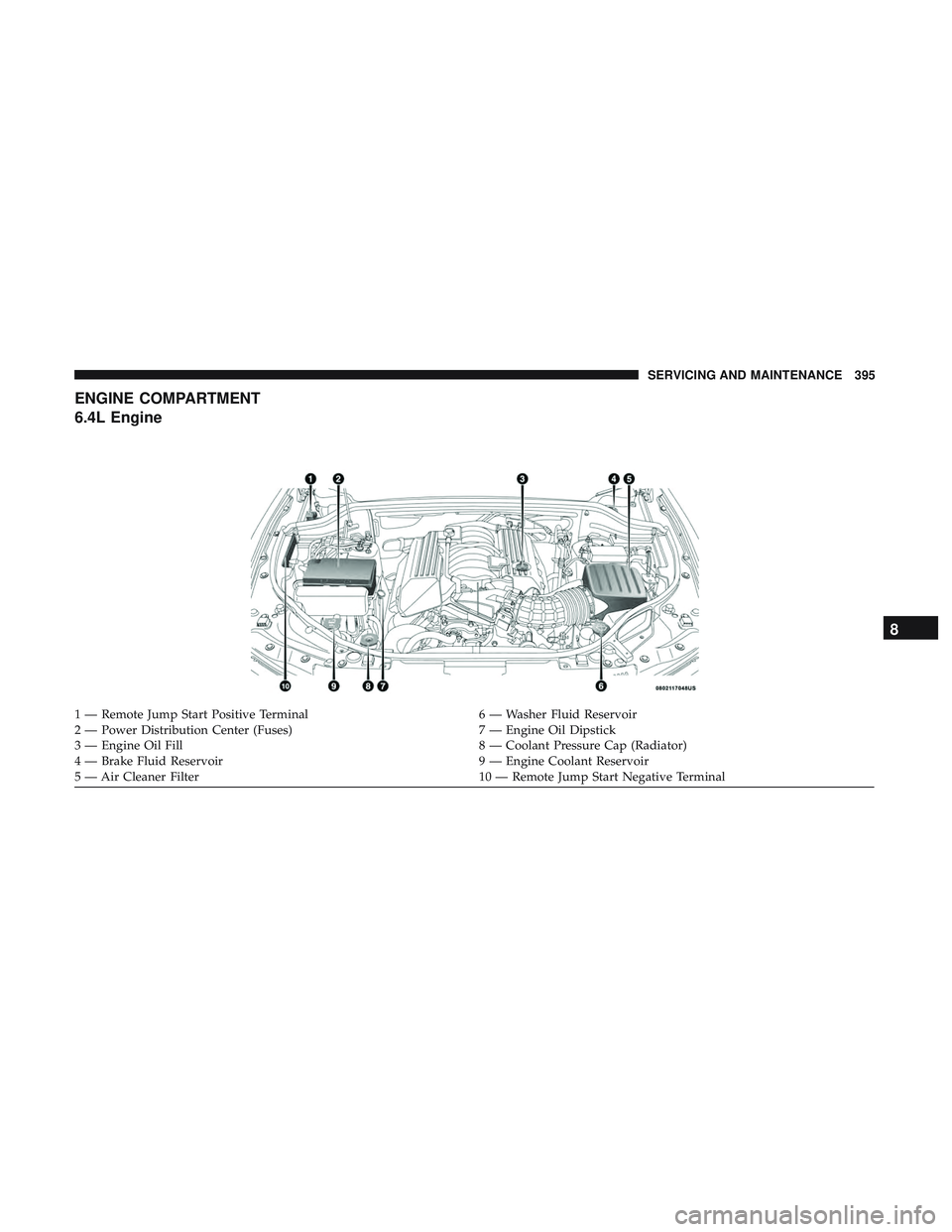
ENGINE COMPARTMENT
6.4L Engine
1 — Remote Jump Start Positive Terminal6 — Washer Fluid Reservoir
2 — Power Distribution Center (Fuses) 7 — Engine Oil Dipstick
3 — Engine Oil Fill 8 — Coolant Pressure Cap (Radiator)
4 — Brake Fluid Reservoir 9 — Engine Coolant Reservoir
5 — Air Cleaner Filter 10 — Remote Jump Start Negative Terminal
8
SERVICING AND MAINTENANCE 395
Page 414 of 568
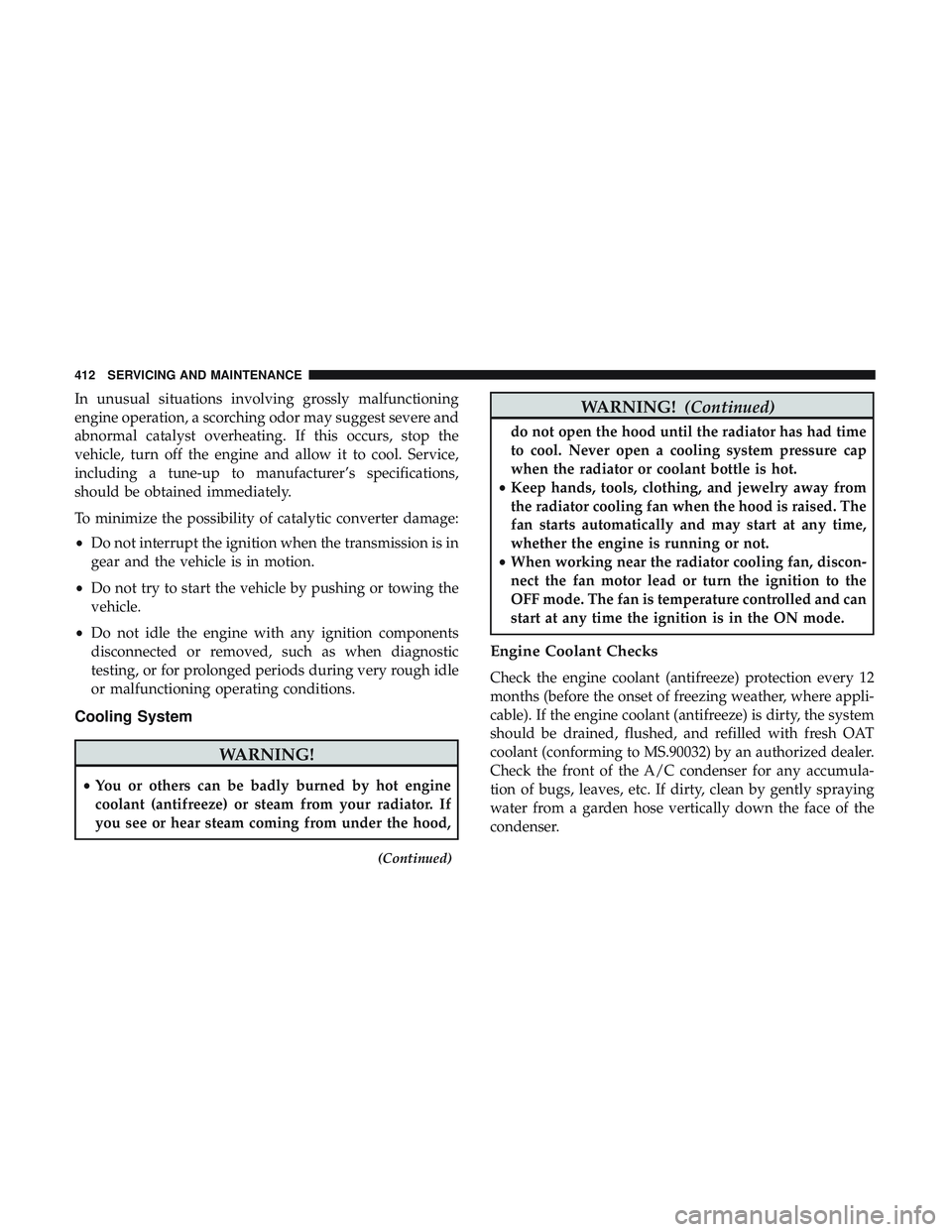
In unusual situations involving grossly malfunctioning
engine operation, a scorching odor may suggest severe and
abnormal catalyst overheating. If this occurs, stop the
vehicle, turn off the engine and allow it to cool. Service,
including a tune-up to manufacturer’s specifications,
should be obtained immediately.
To minimize the possibility of catalytic converter damage:
•Do not interrupt the ignition when the transmission is in
gear and the vehicle is in motion.
• Do not try to start the vehicle by pushing or towing the
vehicle.
• Do not idle the engine with any ignition components
disconnected or removed, such as when diagnostic
testing, or for prolonged periods during very rough idle
or malfunctioning operating conditions.
Cooling System
WARNING!
•You or others can be badly burned by hot engine
coolant (antifreeze) or steam from your radiator. If
you see or hear steam coming from under the hood,
(Continued)
WARNING! (Continued)
do not open the hood until the radiator has had time
to cool. Never open a cooling system pressure cap
when the radiator or coolant bottle is hot.
• Keep hands, tools, clothing, and jewelry away from
the radiator cooling fan when the hood is raised. The
fan starts automatically and may start at any time,
whether the engine is running or not.
• When working near the radiator cooling fan, discon-
nect the fan motor lead or turn the ignition to the
OFF mode. The fan is temperature controlled and can
start at any time the ignition is in the ON mode.
Engine Coolant Checks
Check the engine coolant (antifreeze) protection every 12
months (before the onset of freezing weather, where appli-
cable). If the engine coolant (antifreeze) is dirty, the system
should be drained, flushed, and refilled with fresh OAT
coolant (conforming to MS.90032) by an authorized dealer.
Check the front of the A/C condenser for any accumula-
tion of bugs, leaves, etc. If dirty, clean by gently spraying
water from a garden hose vertically down the face of the
condenser.
412 SERVICING AND MAINTENANCE
Page 415 of 568
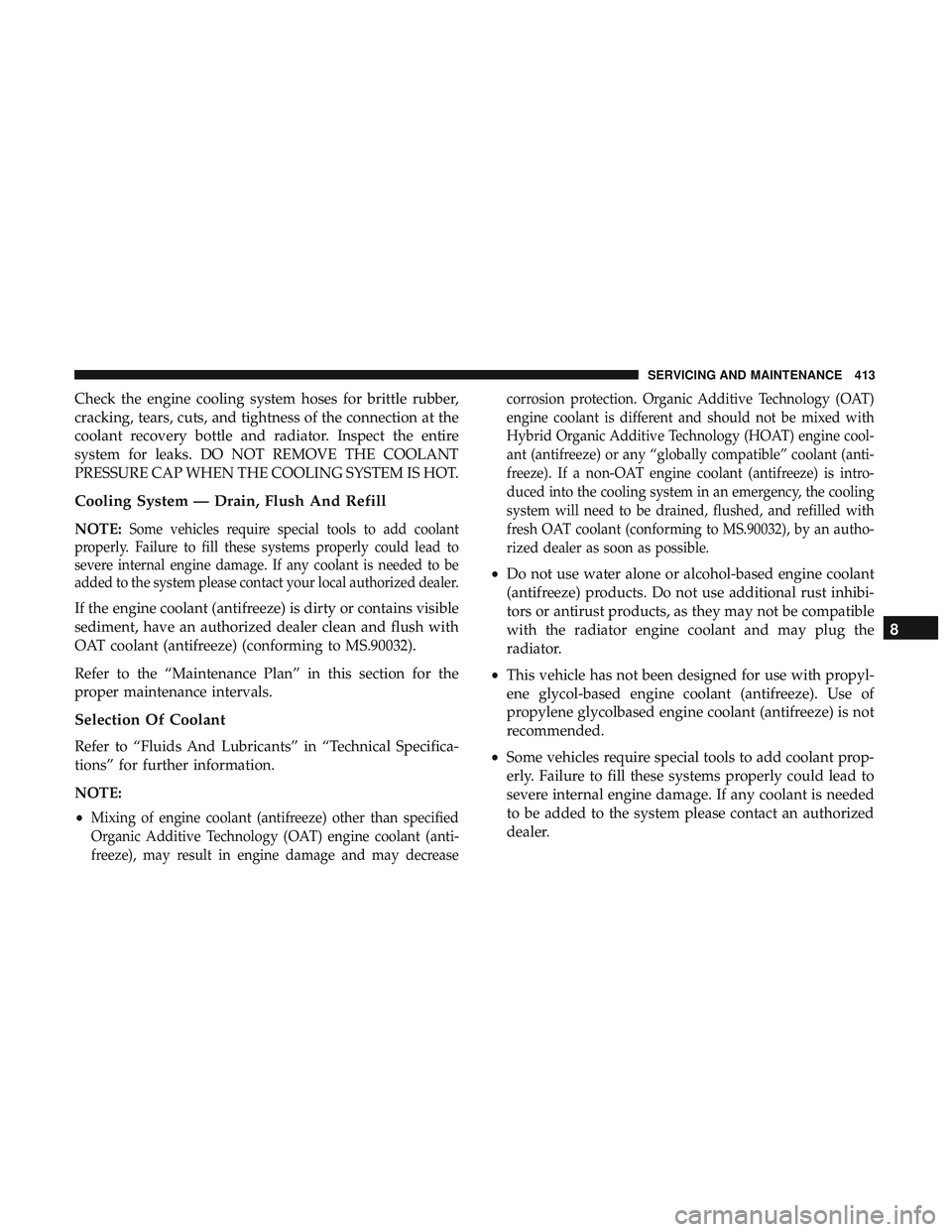
Check the engine cooling system hoses for brittle rubber,
cracking, tears, cuts, and tightness of the connection at the
coolant recovery bottle and radiator. Inspect the entire
system for leaks. DO NOT REMOVE THE COOLANT
PRESSURE CAP WHEN THE COOLING SYSTEM IS HOT.
Cooling System — Drain, Flush And Refill
NOTE:Some vehicles require special tools to add coolant
properly. Failure to fill these systems properly could lead to
severe internal engine damage. If any coolant is needed to be
added to the system please contact your local authorized dealer.
If the engine coolant (antifreeze) is dirty or contains visible
sediment, have an authorized dealer clean and flush with
OAT coolant (antifreeze) (conforming to MS.90032).
Refer to the “Maintenance Plan” in this section for the
proper maintenance intervals.
Selection Of Coolant
Refer to “Fluids And Lubricants” in “Technical Specifica-
tions” for further information.
NOTE:
•
Mixing of engine coolant (antifreeze) other than specified
Organic Additive Technology (OAT) engine coolant (anti-
freeze), may result in engine damage and may decrease corrosion protection. Organic Additive Technology (OAT)
engine coolant is different and should not be mixed with
Hybrid Organic Additive Technology (HOAT) engine cool-
ant (antifreeze) or any “globally compatible” coolant (anti-
freeze). If a non-OAT engine coolant (antifreeze) is intro-
duced into the cooling system in an emergency, the cooling
system will need to be drained, flushed, and refilled with
fresh OAT coolant (conforming to MS.90032), by an autho-
rized dealer as soon as possible.
•
Do not use water alone or alcohol-based engine coolant
(antifreeze) products. Do not use additional rust inhibi-
tors or antirust products, as they may not be compatible
with the radiator engine coolant and may plug the
radiator.
• This vehicle has not been designed for use with propyl-
ene glycol-based engine coolant (antifreeze). Use of
propylene glycolbased engine coolant (antifreeze) is not
recommended.
• Some vehicles require special tools to add coolant prop-
erly. Failure to fill these systems properly could lead to
severe internal engine damage. If any coolant is needed
to be added to the system please contact an authorized
dealer.
8
SERVICING AND MAINTENANCE 413
Page 417 of 568
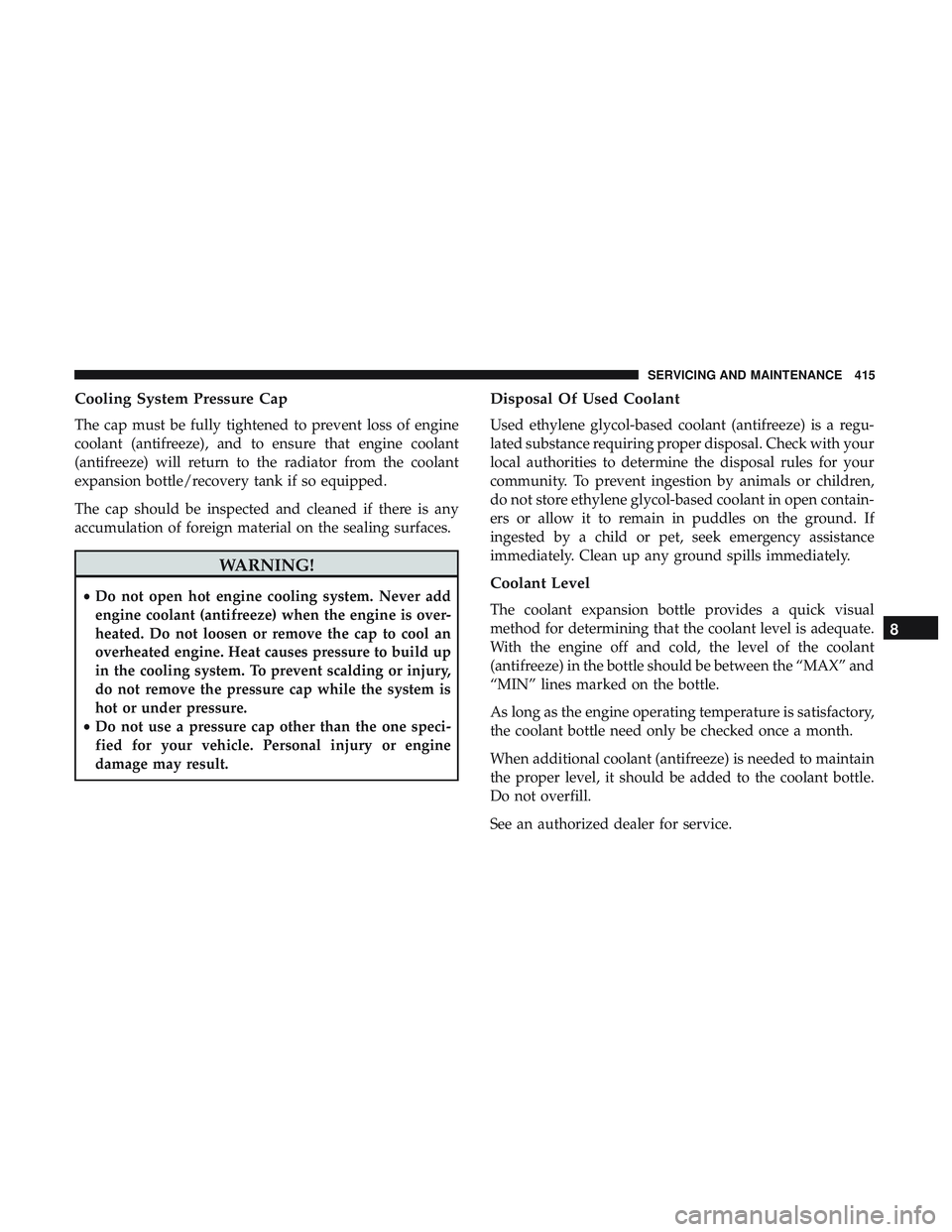
Cooling System Pressure Cap
The cap must be fully tightened to prevent loss of engine
coolant (antifreeze), and to ensure that engine coolant
(antifreeze) will return to the radiator from the coolant
expansion bottle/recovery tank if so equipped.
The cap should be inspected and cleaned if there is any
accumulation of foreign material on the sealing surfaces.
WARNING!
•Do not open hot engine cooling system. Never add
engine coolant (antifreeze) when the engine is over-
heated. Do not loosen or remove the cap to cool an
overheated engine. Heat causes pressure to build up
in the cooling system. To prevent scalding or injury,
do not remove the pressure cap while the system is
hot or under pressure.
• Do not use a pressure cap other than the one speci-
fied for your vehicle. Personal injury or engine
damage may result.
Disposal Of Used Coolant
Used ethylene glycol-based coolant (antifreeze) is a regu-
lated substance requiring proper disposal. Check with your
local authorities to determine the disposal rules for your
community. To prevent ingestion by animals or children,
do not store ethylene glycol-based coolant in open contain-
ers or allow it to remain in puddles on the ground. If
ingested by a child or pet, seek emergency assistance
immediately. Clean up any ground spills immediately.
Coolant Level
The coolant expansion bottle provides a quick visual
method for determining that the coolant level is adequate.
With the engine off and cold, the level of the coolant
(antifreeze) in the bottle should be between the “MAX” and
“MIN” lines marked on the bottle.
As long as the engine operating temperature is satisfactory,
the coolant bottle need only be checked once a month.
When additional coolant (antifreeze) is needed to maintain
the proper level, it should be added to the coolant bottle.
Do not overfill.
See an authorized dealer for service.
8
SERVICING AND MAINTENANCE 415
Page 418 of 568
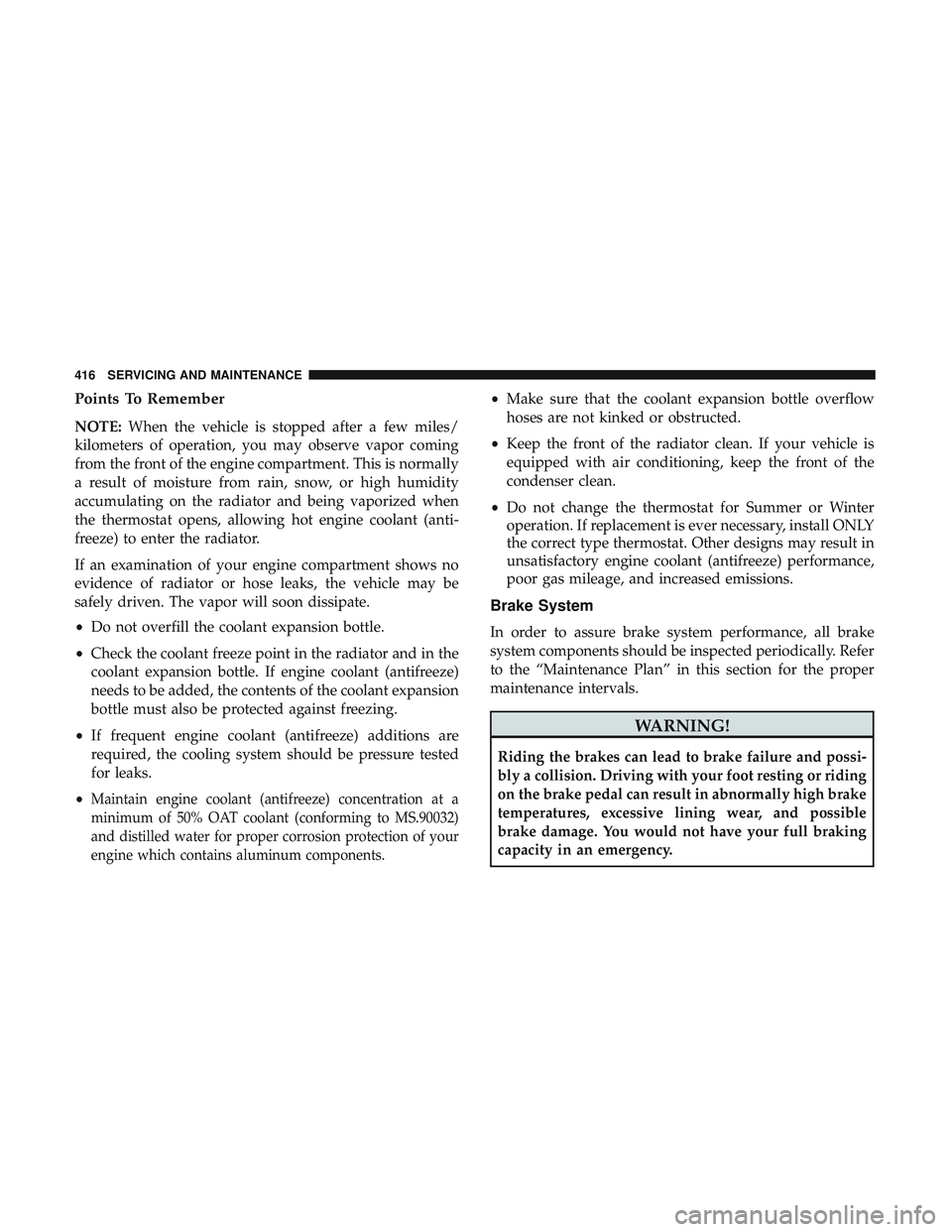
Points To Remember
NOTE:When the vehicle is stopped after a few miles/
kilometers of operation, you may observe vapor coming
from the front of the engine compartment. This is normally
a result of moisture from rain, snow, or high humidity
accumulating on the radiator and being vaporized when
the thermostat opens, allowing hot engine coolant (anti-
freeze) to enter the radiator.
If an examination of your engine compartment shows no
evidence of radiator or hose leaks, the vehicle may be
safely driven. The vapor will soon dissipate.
• Do not overfill the coolant expansion bottle.
• Check the coolant freeze point in the radiator and in the
coolant expansion bottle. If engine coolant (antifreeze)
needs to be added, the contents of the coolant expansion
bottle must also be protected against freezing.
• If frequent engine coolant (antifreeze) additions are
required, the cooling system should be pressure tested
for leaks.
•
Maintain engine coolant (antifreeze) concentration at a
minimum of 50% OAT coolant (conforming to MS.90032)
and distilled water for proper corrosion protection of your
engine which contains aluminum components.
• Make sure that the coolant expansion bottle overflow
hoses are not kinked or obstructed.
• Keep the front of the radiator clean. If your vehicle is
equipped with air conditioning, keep the front of the
condenser clean.
• Do not change the thermostat for Summer or Winter
operation. If replacement is ever necessary, install ONLY
the correct type thermostat. Other designs may result in
unsatisfactory engine coolant (antifreeze) performance,
poor gas mileage, and increased emissions.
Brake System
In order to assure brake system performance, all brake
system components should be inspected periodically. Refer
to the “Maintenance Plan” in this section for the proper
maintenance intervals.
WARNING!
Riding the brakes can lead to brake failure and possi-
bly a collision. Driving with your foot resting or riding
on the brake pedal can result in abnormally high brake
temperatures, excessive lining wear, and possible
brake damage. You would not have your full braking
capacity in an emergency.
416 SERVICING AND MAINTENANCE
Page 553 of 568
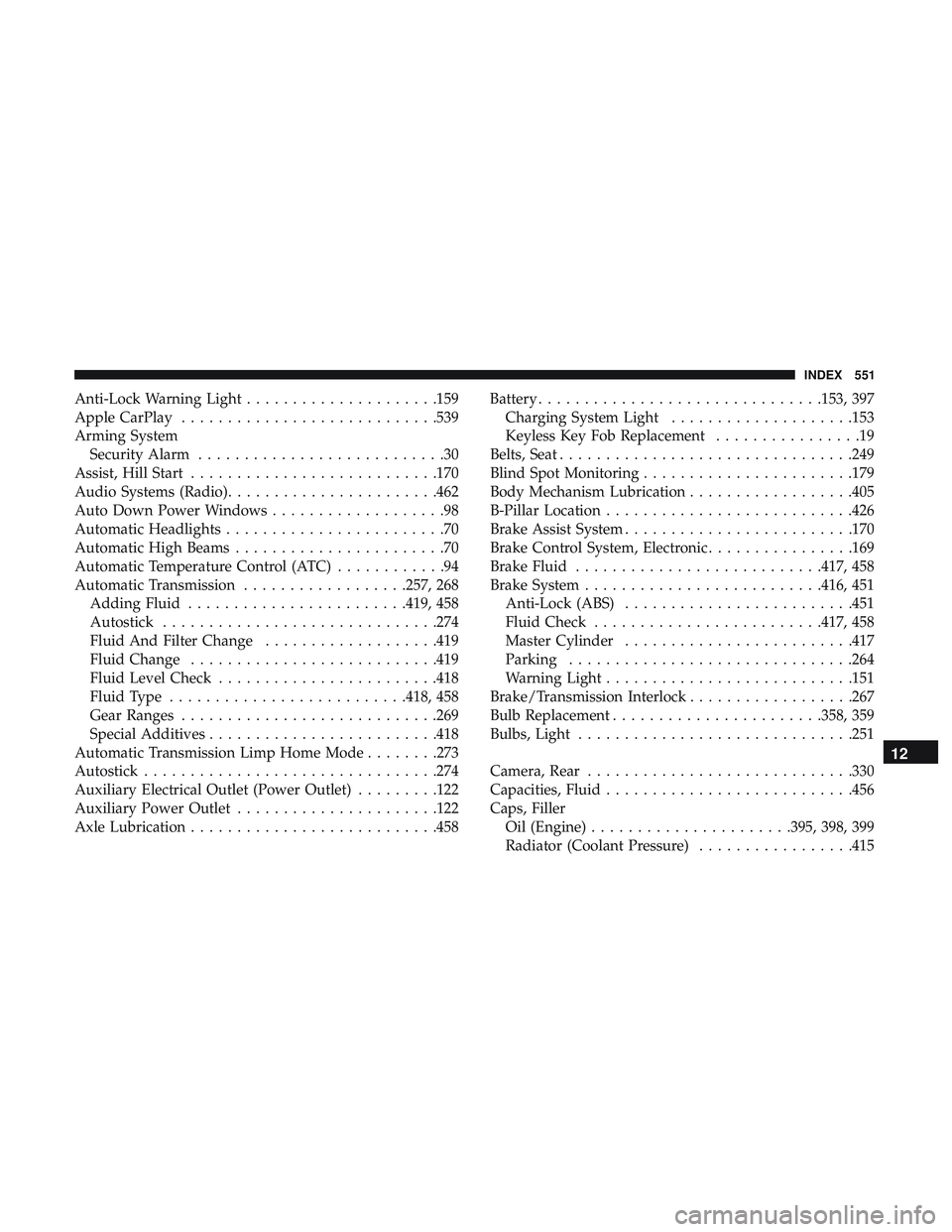
Anti-Lock Warning Light.....................159
Apple CarPlay ............................539
Arming System Security Alarm ...........................30
Assist, Hill Start .......................... .170
Audio Systems (Radio) .......................462
Auto Down Power Windows ...................98
Automatic Headlights ........................70
Automatic High Beams .......................70
Automatic Temperature Control (ATC) ............94
Automatic Transmission ..................257, 268
Adding Fluid ........................419, 458
Autostick ............................. .274
Fluid And Filter Change ...................419
Fluid Change .......................... .419
Fluid Level Check ........................418
Fluid Type ..........................418, 458
Gear Ranges ............................269
Special Additives ........................ .418
Automatic Transmission Limp Home Mode ........273
Autostick ............................... .274
Auxiliary Electrical Outlet (Power Outlet) .........122
Auxiliary Power Outlet ..................... .122
Axle Lubrication .......................... .458Battery
...............................153, 397
Charging System Light ....................153
Keyless Key Fob Replacement ................19
Belts, Seat ............................... .249
Blind Spot Monitoring .......................179
Body Mechanism Lubrication ..................405
B-Pillar Location .......................... .426
Brake Assist System ........................ .170
Brake Control System, Electronic ................169
Brake Fluid .......................... .417, 458
Brake System ..........................416, 451
Anti-Lock (ABS) ........................ .451
Fluid Check ........................ .417,458
Master
Cylinder ........................ .417
Parking ...............................264
Warning Light .......................... .151
Brake/Transmission Interlock ..................267
Bulb Replacement .......................358, 359
Bulbs, Light ............................. .251
Camera, Rear ............................ .330
Capacities, Fluid .......................... .456
Caps, Filler Oil (Engine) ..................... .395, 398, 399
Radiator (Coolant Pressure) .................415
12
INDEX 551
Page 554 of 568
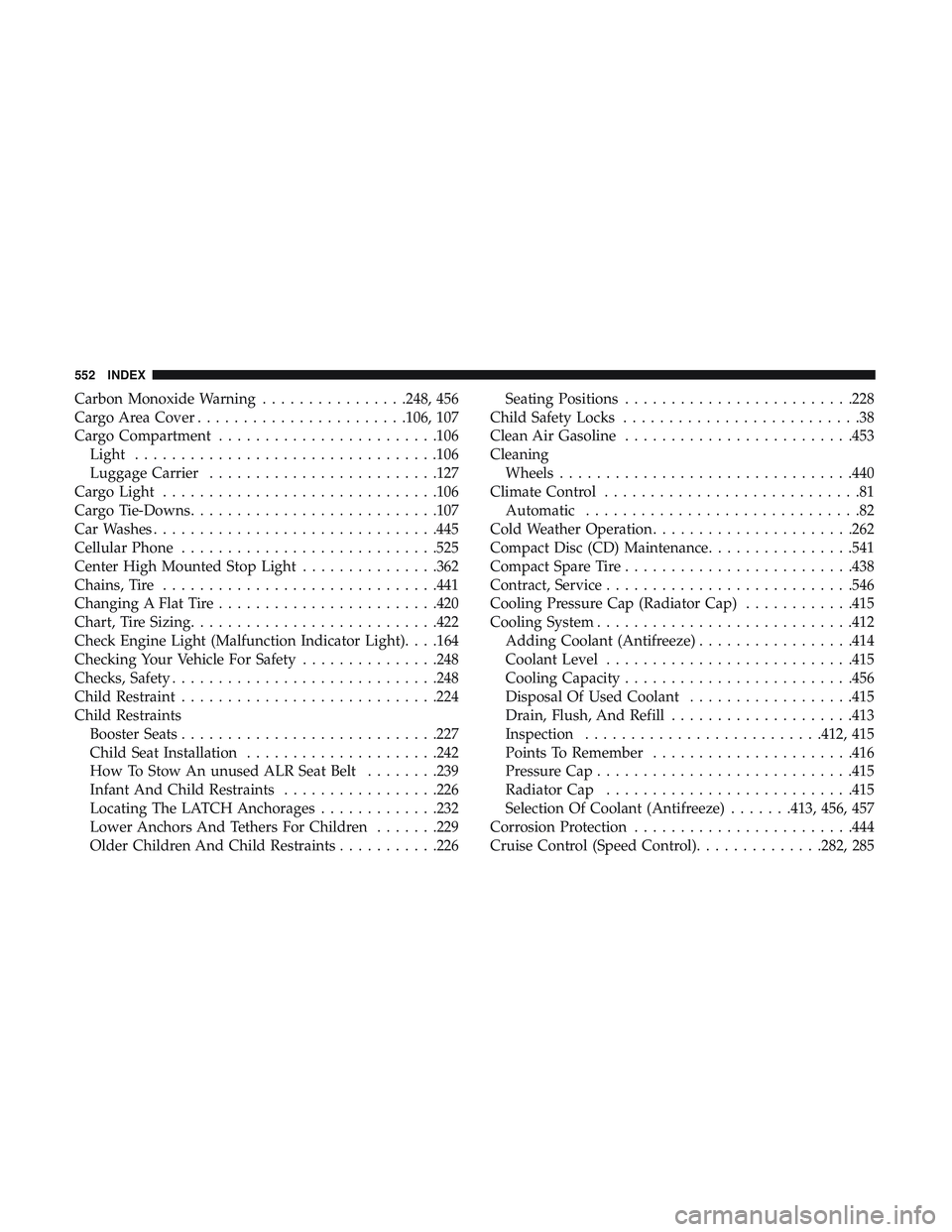
Carbon Monoxide Warning................248, 456
Cargo Area Cover .......................106, 107
Cargo Compartment ........................106
Light .................................106
Luggage Carrier ........................ .127
Cargo Light ............................. .106
Cargo Tie-Downs .......................... .107
Car Washes ...............................445
Cellular Phone ............................525
Center High Mounted Stop Light ...............362
Chains, Tire ............................. .441
Changing A Flat Tire ........................420
Chart, Tire Sizing .......................... .422
Check Engine Light (Malfunction Indicator Light). . . .164
Checking Your Vehicle For Safety ...............248
Checks, Safety ............................ .248
Child Restraint ............................224
Child Restraints Booster Seats ............................227
Child Seat Installation .....................242
How To Stow An unused ALR Seat Belt ........239
Infant And Child Restraints .................226
Locating The LATCH Anchorages .............232
Lower Anchors And Tethers For Children .......229
Older Children And Child Restraints ...........226Seating Positions
........................ .228
Child Safety Locks ..........................38
Clean Air Gasoline ........................ .453
Cleaning Wheels ............................... .440
Climate Control ............................81
Automatic ..............................82
Cold Weather Operation ..................... .262
Compact Disc (CD) Maintenance ................541
Compact Spare Tire ........................ .438
Contract, Service .......................... .546
Cooling Pressure Cap (Radiator Cap) ............415
Cooling System............................412
Adding
Coolant (Antifreeze) .................414
Coolant Level .......................... .415
Cooling Capacity ........................ .456
Disposal Of Used Coolant ..................415
Drain, Flush, And Refill ....................413
Inspection ..........................412, 415
Points To Remember ..................... .416
Pressure Cap ............................415
Radiator Cap .......................... .415
Selection Of Coolant (Antifreeze) .......413, 456, 457
Corrosion Protection ........................444
Cruise Control (Speed Control) ..............282, 285
552 INDEX
Page 561 of 568
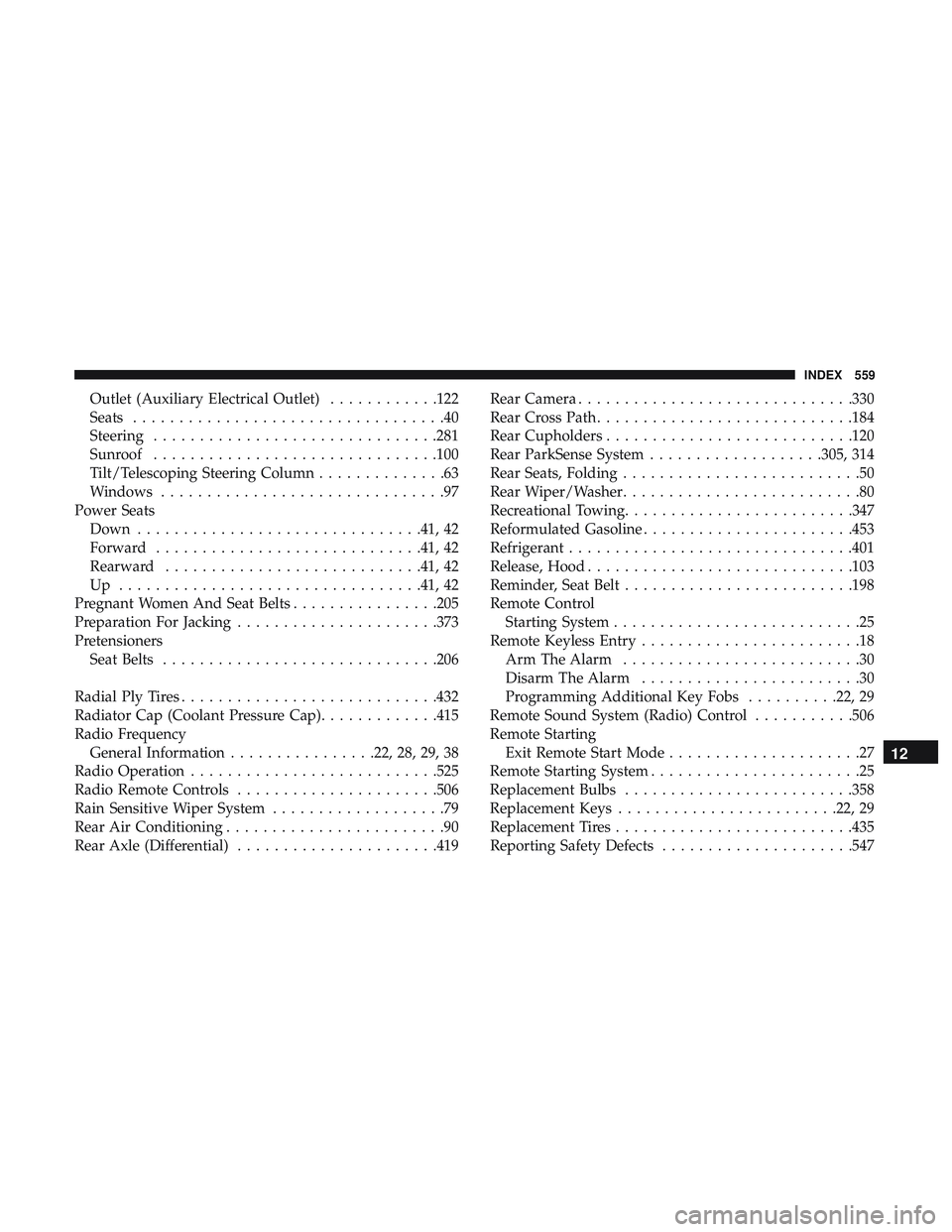
Outlet (Auxiliary Electrical Outlet)............122
Seats ..................................40
Steering ...............................281
Sunroof ...............................100
Tilt/Telescoping Steering Column ..............63
Windows ...............................97
Power Seats Down ...............................41, 42
Forward ............................ .41, 42
Rearward ............................41, 42
Up .................................41, 42
Pregnant Women And Seat Belts ................205
Preparation For Jacking ..................... .373
Pretensioners Seat Belts ............................. .206
Radial Ply Tires ............................432
Radiator Cap (Coolant Pressure Cap) .............415
Radio Frequency General Information ................22, 28, 29, 38
Radio Operation .......................... .525
Radio Remote Controls ..................... .506
Rain Sensitive Wiper System ...................79
Rear Air Conditioning ........................90
Rear Axle (Differential) ..................... .419Rear Camera
............................. .330
Rear Cross Path ............................184
Rear Cupholders .......................... .120
Rear ParkSense System ...................305, 314
Rear Seats, Folding ..........................50
Rear Wiper/Washer ..........................80
Recreational Towing ........................ .347
Reformulated Gasoline .......................453
Refrigerant ...............................401
Release, Hood ............................ .103
Reminder, Seat Belt ........................ .198
Remote Control Starting System ...........................25
Remote Keyless Entry ........................18
Arm The Alarm ..........................30
Disarm The Alarm ........................30
Programming Additional Key Fobs ..........22,29
Remote
Sound System (Radio) Control ...........506
Remote Starting Exit Remote Start Mode .....................27
Remote Starting System .......................25
Replacement Bulbs ........................ .358
Replacement Keys ........................22, 29
Replacement Tires ..........................435
Reporting Safety Defects .....................547
12
INDEX 559